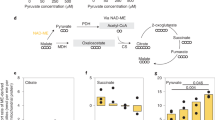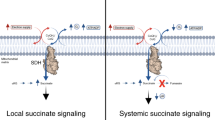Abstract
Since Quastel and Whetham's discovery in 19251, biochemists have come to regard the malonate ion as one of the very few specific enzyme inhibitors—as a competitive inhibitor of succinic dehydrogenase2 Malonate has therefore been widely used with animal tissue, in work designed to elucidate the Krebs cycle. Recently it has also been applied to plant tissues, but with discordant results. Machlis3 showed that malonate inhibited part of the respiration of barley roots; but several other workers have independently stated that malonate does not inhibit and may even stimulate plant respiration4–7.
This is a preview of subscription content, access via your institution
Access options
Subscribe to this journal
Receive 51 print issues and online access
$199.00 per year
only $3.90 per issue
Buy this article
- Purchase on Springer Link
- Instant access to full article PDF
Prices may be subject to local taxes which are calculated during checkout
Similar content being viewed by others
References
Quastel, J. H., and Whetham, M. D., Biochem. J., 19, 520(1925).
Potter, V. R., and Dubois, K. D., J. Gen. Physiol., 24, 391 (1943).
Machlis, L., Amer. J. Bot., 31, 183 (1944).
Bennet Clark, T. A., and Bexon, D., New Phytol., 42, 65 (1943).
Henderson, J. H. M., and Stauffer, J. F., Amer. J. Bot., 31, 528 (1944).
Albaum, H. G., and Eichel, B., Amer. J. Bot., 30, 18 (1943).
Burris, R. H., and Wilson, P. W., Cold Spring Harbor Symposium of Biology, 7, 349 (1939).
Turner, J. S., New Phytol., 37, 232 (1938).
Robertson, R. N., and Turner, J. S., Aust. J. Exp. Biol. and Med. Sci., 23, 63 (1945).
Marsh, P. B., and Goddard, D. R., Amer. J. Bot., 26, 724 (1939).
Ulrich, A., Amer. J. Bot., 28, 526 (1941).
Turner, J. S., Aust. J. Exp. Biol. and Med. Sci., 18, 273 (1940).
Robertson, R. N., Turner, J. S., and Wilkins, M. J., Aust. J. Exp. Biol. and Med. Sci., in the press.
Author information
Authors and Affiliations
Rights and permissions
About this article
Cite this article
TURNER, J., HANLY, V. Malonate and Plant Respiration. Nature 160, 296–297 (1947). https://doi.org/10.1038/160296a0
Issue Date:
DOI: https://doi.org/10.1038/160296a0
This article is cited by
-
Metabolism in plant storage tissue slices
The Botanical Review (1974)
-
Effect of pH on the Activity of some Respiratory Inhibitors
Nature (1949)
Comments
By submitting a comment you agree to abide by our Terms and Community Guidelines. If you find something abusive or that does not comply with our terms or guidelines please flag it as inappropriate.



